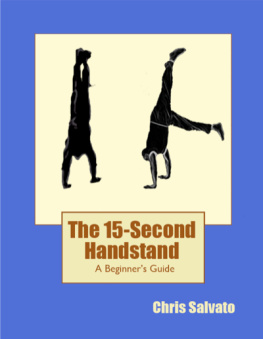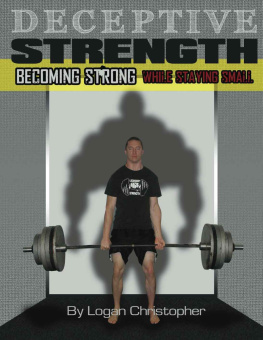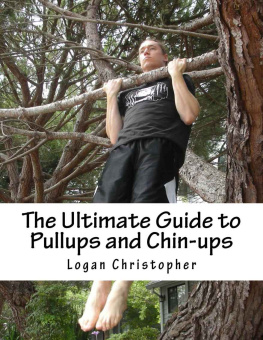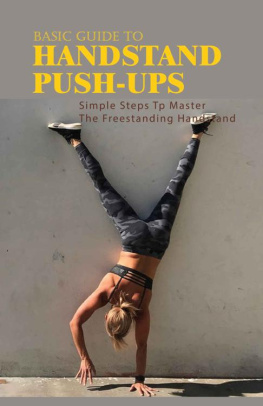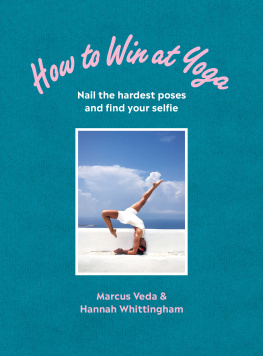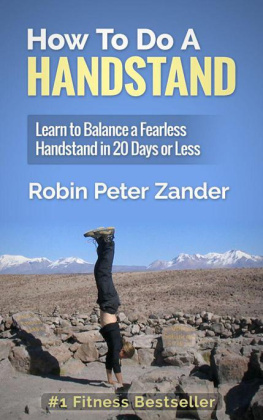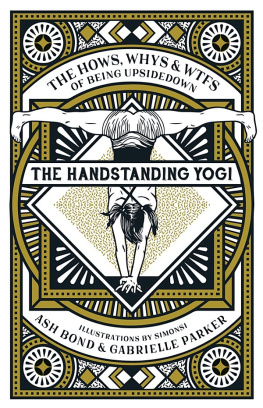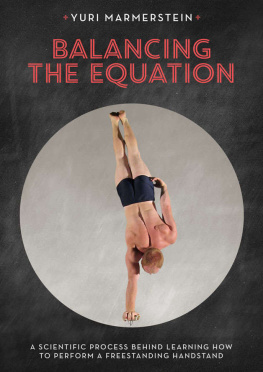The 15-Second Handstand
A Beginners Guide
by Chris Salvato
Copyright 2013 Chris Salvato
All rights reserved No pan of this publication may be reproduced, stored in a retrieval system or transmitted in a form by means, electronic, mechanical, photocopied, recorded, or otherwise without the poor written consent of the publisher. The authors and publisher disclaim any responsibility for any adverse effects or consequences from the misapplication or injudicious use of the information presented in this text.
Swift Archer LLC
500 North Rainbow Boulevard, Suite 300A, Las Vegas, NV 89107, USA
Dedicated to Serena who encouraged me to finish each page, to my enthusiastic readers who showed me I had knowledge worth sharing, and to my teachers to whom I owe everything.
Acknowledgements
Many thanks to Serena Thomson, my future wife and best friend, who encouraged me to finish every page.
This book would certainly not have happened without the support of Steven Low, a true bodyweight fitness mentor who helped me achieve nearly all of my fitness goals in an astoundingly short time.
The contributions of Steven, along with those from Jim Bathurst of Beast Skills, Ido Portal and the CrossFit communities have pushed fitness back in the right direction. Without a community focused on self-mastery, this book would be wholly irrelevant.
A big thanks to my mother and father, who dont always understand what I am doing (or why), but continue to support my endeavors fully.
And, finally, a big thanks to the online gymnastics and bodyweight fitness communities that have been reading my works for years, pushing their limits, and becoming more useful and impressive. My goal is to help bring more dedicated people among our ranks.
Disclaimer
By using Beginner's Handstand Guide (hereafter as referred to the "Book"), you (hereafter referred to as the "User") signify your agreement to these Terms and Conditions. If you do not agree to all of these Terms and Conditions of use, do not use the Book!
The use of the Book and suggested workouts, exercise routines, nutritional suggestions, or other suggestions is at your own risk . In no event shall the Book, its authors, editors, illustrators, its suppliers, or any third parties mentioned in the Book be liable for any damages in the future including, but not limited to, heart attacks, muscle strains, pulls or tears, neck, back, shoulder, elbow, wrist, hand, finger and/or hip injuries, and other illness/disease, or injury/damage (mental, physical, financial), however caused, occurring during or after altering any personal nutritional, fitness, lifestyle habits or actions. The Book and author do not assume any responsibility for any aspect of healthcare administered with the aid of content available in the book. User understands that any and all advice/programs concerning exercise is not done under supervision of a qualified trainer and nutrition is for educational purposes only. User has been advised to seek medical advice from a physician before altering their nutritional daily diet or beginning an exercise program.
Foreword
I have been performing handstands for years and teaching anyone who wanted to listen everything that I have learned along the way. When I wrote a short article on my blog ( http://www.eatmoveimprove.com ) about handstands, I was floored with the response. The internet and book shelves across the globe are rife with materials about the handstand and hand balancing. There seems to be an overabundance of information available. So why are so many people interested in what I had to say?
In the 20th century, the western world has lost sight of simply moving our bodies through space. A vast majority of gyms are filled with machinery meant to work muscles, but not bodies. Fitness and health, like so many other parts of our lives, has turned into a grind. Going to the gym is seen as another horrible necessity that we must perform if we want to avoid the tyranny of disease, ugliness and untimely death. How very grim. The fitness world has seem to swung into habits to avoid despair.
These sorts of things, however, go in swings and roundabouts. Nature has a way of correcting itself, and I believe that fitness trends are swinging back in the right direction. We are moving towards enjoying our workouts and their results. As more people learn to master themselves, their own bodies, the fitness industry moves in the right direction. Conquering your body and the physical world is impressive and rewarding, and as you do do, moving weights attached to strings and pulleys loses its appeal.
There is no feeling quite as rewarding as that of mastering moving yourself through space - whether it be in running, jumping, climbing or hand balancing. Even more rewarding is when your new abilities unlocks a whole world before you. Runners often experience this when they run their first mile effortlessly, craving to run their first 5k, then their first marathon. Similarly, the handstand unlocks an array of advanced and impressive feats of strength and skill. It shatters the monotonous world of treadmills and Smith machines, making it nearly impossible to go back. Yet, there is still a struggle to get started.
When I first learned to handstand, it took me over one year to get my first 15-second freestanding hold. It took me that long to put together all of the pieces of the puzzle and learn what worked. I developed an addiction to handstands. I was obsessed with getting it right. One year is far too long, though. Eventually, I was able to get other people to their first handstand in a fraction of the time.
When writing this book, my goal was to provide information and insights about the handstand as it should be understood by beginners so that you can attain your first handstand in weeks, not years. The intended audience are the complete beginners, not those with years of hand balance training. The intended audience needs a program they can start today without understanding the details.
This book lays out a minimalistic program that will enable you to perform your first handstand like many others before you. Perfect form is not the goal for a beginner, and not the goal of this book. As a beginner, your goal is to stand on your hands, and my goal is to get you there.
Over the better part of a decade, I have refined this material to enable newcomers to get their first 15-second freestanding handstand within as little at 40 days. My program attacks the difficulties in learning the handstand as an adult, and boils it down into the simplest possible steps. The rest of this book explains why these methods work so well, and will broaden your understanding as you tackle advanced (and impressive) handstand and bodyweight skills training.
I. Get Started. Right Now.11
II. Handstands, Strength and Skills55
III. The Psychology of Progress63
IV. The Physics of Balance67
V. The Physiology of Posture109
VI. Appendix: Alternative Progression127
Get Started. Right Now.
The main tenet in this book is that most people can get to their first 60-second handstand against the wall within 28 days and their first freestanding handstand within 60 days. In fact, you are probably a lot farther along than you think.
You are reading right now because you want to learn handstands, so why wait until you are done with this book to get started? Instead, start right now. There is no reason to delay. It doesn't really matter how old, weak, frail or clumsy you are; start right now. Once you start executing the steps in this program, the details in the rest of the book will be in much better context.
Two Step Method
The handstand isnt really that hard. It seems difficult to you because your brain has been programmed your whole life to stand on your feet and stay upright. As a result, most of the problems with learning the handstand are not with your body. Theyre with your brain. The good news is that we can get past that.
Next page
